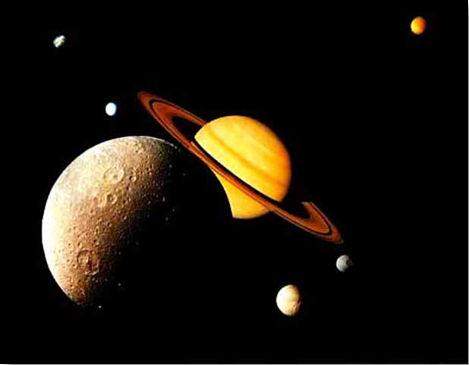Global color maps reveal provocative patterns on Saturn''s five icy satellites
 Washington, October 6 : New global color maps reveal provocative patterns on the surfaces of Saturn''s five innermost large icy satellites, namely, Mimas, Enceladus, Tethys, Dione, and Rhea.
Washington, October 6 : New global color maps reveal provocative patterns on the surfaces of Saturn''s five innermost large icy satellites, namely, Mimas, Enceladus, Tethys, Dione, and Rhea.
These new maps have been presented in a report by Dr. Paul Schenk of Houston''s Lunar and Planetary Institute at the AAS Division for Planetary Sciences meeting in Puerto Rico.
They reveal complex global color patterns on each of these satellites, including color asymmetries on four of these moons and equatorial banding on three.
The patterns indicate that particles within the Saturn system have significant effects on the surfaces of these icy bodies.
These new maps will ultimately provide new constraints on the dynamics of particles and grains within the Saturn system, including the apparent impact of Rhea ring material directly onto its surface.
They represent the first comprehensive color mapping of all of Saturn''s mid-sized icy moons together.
They were created by Dr. Schenk from images acquired by Cassini''s solid state imager over the first 4 years of the mission and have resolutions of between 400 and 750 meters.
These maps cover the infrared to the ultraviolet spectral range, which is beyond the range of human sight, and show distinct patterns on each moon.
The most striking patterns are revealed when we compare colors by dividing the infrared (IR) brightness by the ultraviolet (UV) brightness map.
These IR/UV ratio maps provide a measure of the so-called redness of the surface, defined by enhanced absorption at shorter wavelengths.
The maps reveal that except for Mimas, all the inner moons have strong IR/UV ratio enhancements (that is, they are redder) on their trailing hemispheres.
This reddening is strongest at the center of the trailing hemisphere, and is also seen by the Cassini VIMS instrument.
One surprise is that the pattern for Enceladus is offset 20 degrees to the west. The origin of this offset is unclear, but could relate to reimpact of plume material.
A curiosity from Voyager observations was the dark equatorial lens-shaped band across the front-side of Tethys.
This feature is very prominent in the new Cassini color maps as an IR-dark, UV-bright feature.
An unexpected discovery is that long-neglected Mimas also has a prominent equatorial lens-shaped band about 175-kilometers wide stretching across its leading side as well.
Another surprise was the discovery of a very narrow and straight band of discrete UV-bright features very close to (within 2 degrees of) Rhea''s equator.
These features are resolved at higher resolution as bluish splotch-marks that form a very narrow chain only a few kilometers wide across the center of the leading hemisphere of Rhea. (ANI)